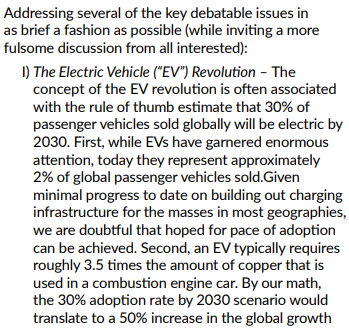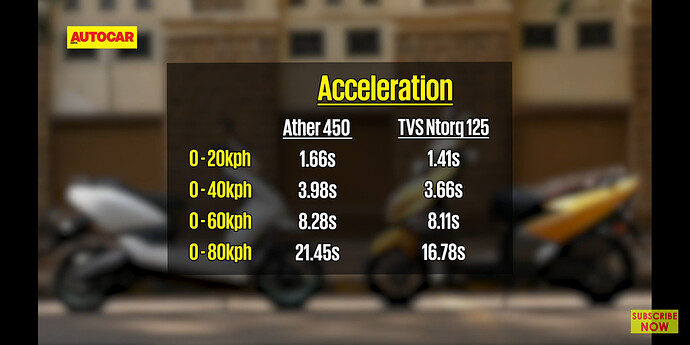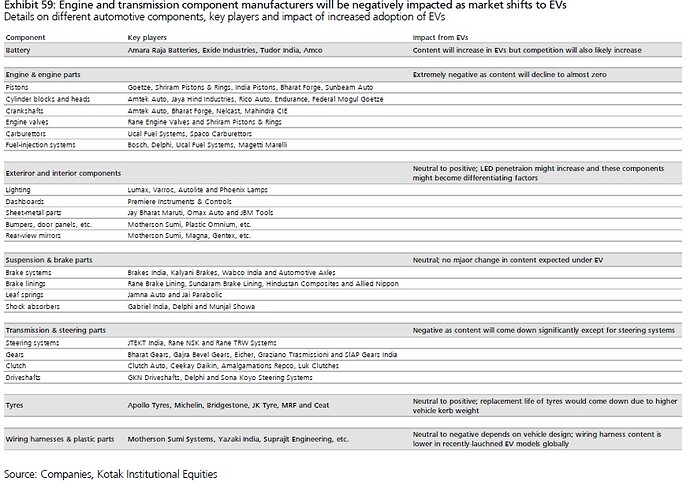Battery integrated business that includes cell manufacturing, battery recycling, and battery production.
The above statistics shows how the 2x priced EV lags behind the ICE counterpart in 2019. This will change soon and will be interesting metric to help us find the possibility of switch to EV
company claims that the Kona EV delivers a range of 452 km in one single charge under standard conditions
the Korean firm aims to have 44 environment-friendly models in its lineup, including 23 full-electric models, by 2025
Hi All,
I came across a Kotak report on Automobiles and Components (attached). I am summarizing the main points for everyone.
Overall Sector:
It is expected that 28% of automobiles (including 2/3-wheelers, except commercial vehicles) will shift to EVs by FY2030 with scooters and 3-wheelers adopting much faster.
For 4-wheelers, total cost of ownership (TCO) vs. ICE will be achieved by CY2025.
For 2/3 wheelers, total cost of ownership (TCO) has already been achieved.
Lithium battery prices are expected to fall from USD 94/kW Hr by CY2024 and further to USD 62/kW Hr by CY2030.
No. of charging stations have increased exponentially in US, China, Europe, Currently China has 3,00,000 public chargers, 1,55,247 for Europe and 67,395 for US. Negligible charging infrastructure in India.
Technology Maturity –
HEV/BEV – Currently available
Methanol Vehicles – 2025+
Fuel Cell – After 2030
2 Wheelers:
Current recovery/breakeven time for AtherS340 Vs Honda Activa is 1.6 Years (with govt incentives, 10,000 km run annually)
75% of urban customers and 25% of rural customers will shift to electric scooters by 2030.
Expected that 50% of scooters (moped) will shift to electric by FY2030. ( Current limitation is due to limited production by new manufactures such as Ather, Okinawa etc. while no launches from existing bigger players)
TCO for electric motorcycles higher than petrol due to higher size of batteries. Estimated that 20% of motorcycle will shift to electric by FY2030.
3-Wheelers:
Three-wheelers may shift to electric sooner than expected due to higher running annually. The breakeven cost is less than 2 years (with govt incentives). Expected that 52% of 3-wheelers will shift to electric by FY2030.
4-Wheelers:
Shift to electric in PV’s will be muted. TCO is still very high compared to petrol cars. Even in 2030 the breakeven cost w.r.t to petrol cars will still be 5 years.
In Taxi segment, the economics are more favourable due to higher usage. Breakeven will be around 2 years but constraint is public charging infrastructure.
Estimated PV will be only 5% by FY2030, unless higher incentives by govt. Also it will be mostly taxi segment.
Increase in EV adoption is margin dilutive for OEMS initially due to higher overheads costs.
Auto Components:
It would be negative for ‘traditional’ automotive component suppliers due to lack of an engine, reduction in transmission content, reduced maintenance and spares in EVs.
Beneficiaries would be battery manufactures, suppliers of electronic components and EV chargers. Currently none of the major listed names are present in these categories.
Negligible impact on tire manufactures, interior exterior parts such as bumpers, door panel, instrument panel, seats, and rear - view mirrors.
Kotak.pdf (608.7 KB)
This is a big thread and honestly every time I read, I cannot make out any logical conclusion or directional thoughts. Maybe my bad, can anyone pls summarize the thoughts and long term beneficiaries of EV disruption in listed space? Let’s not consider pure cyclicals at all as we have seen how that ends…
My thoughts on beneficiaries over long term are ABB, Siemens, Tata Chemicals and maybe Tata Power…thoughts welcome!
The Battery Revolution.
Sharing post as it is EV related -
Massive shift in strategy!
Niti’s Methanol Plan for Petrol Vehicles On the Backburner
Strategy changed as govt shifts focus to EVs; methanol push to continue for telecom towers, gensets
New Delhi:
The Niti Aayog has put the brakes on its plans for the use of methanol as an alternative fuel for petrol-run vehicles, in a major shift in strategy as the government’s focus has now moved to electrification of vehicles.
However, the Aayog will continue to push usage of methanolrun gensets, telecom towers and other stationary power units besides methanol-blended fuel for cooking, as India goes all out to reduce its oil import bill across sectors.
Niti Aayog member VK Saraswat had drawn up an ambitious ‘methanol economy’ roadmap under which the government think tank had foreseen an annual reduction of $100 billion in crude imports by 2030, if the country moved to 15% blended fuel, both for transportation and cooking. Blended fuel would also help reduce fuel prices by at least 10%, making it cheaper to run vehicles, it had estimated.
A senior government official told ET that e-mobility had taken precedence over anything else. “We are now looking at strategies for early introduction of alternate fuel that include import of methanol and putting it to use for stationary power plants and for vehicles in the transition phase,” the official said, requesting anonymity.
According to the official, trials for 15% blending of methanol have got over. “We have identified Indian Oil Corp to do blending of methanol and will soon move a Cabinet note to get the government’s approval on the same,” the official said.
As part of its initiative to push for e-mobility in a big way, the government has earmarked ₹10,000 crore under the Faster Adoption and Manufacturing of Hybrid and Electric Vehicles (FAME-II) scheme, to have 1 million electric buses on the Indian roads in the next three years, as well as for a complete shift to electric two-wheelers and three-wheelers.
A high-level panel on transformative mobility led by Niti Aayog chief executive Amitabh Kant had recommended the complete switch to electric three-wheelers and two-wheelers in a phased manner, starting March 31, 2023.
India is the third biggest oil importer globally. According to the oil ministry’s Petroleum Planning and Analysis Cell, India spent $111.9 billion on oil imports in 2018-19. Fuel consumption is estimated to be 2,900 crore litres of petrol and 9,000 crore litres of diesel a year.
Electric car will recharge within 9 minutes
Lessons from Solar Power industry in India to EV industry. From lot of potential to dud.I see similar pattern play out. Need to fix them first to enable orderly growth
- Inconsistent Regulatory policy
- Reliance on China imports
- Lack of Infrastructure before roll-out
- Price of Substitute
- Too much thrust on clean energy than customer acceptance
- Viability from customer Point of view
- Irrational Competitive bidding
- Unsustainable subsidy program
Tata Group companies seems to be working together in creating a sustainable EV ecosystem by different group companies investing in Li-ion cells, vehicles, charging infrastructure and financing etc.
Would investing in select TATA companies be a good investing idea?
Good read on how a US fund manager sees EV’s revolution shaping up (point #1-#3 starting page #3). His views are from standpoint of his biggest position in BMW.

https://thirdave.com/wp-content/uploads/2019/07/2019-Q2-TAVFX-Shareholder-Letter.pdf
While cobalt does come from DRC which has child labour issues, Lithium is found globally, mostly comes from S America, Australia, safe jurisdictions. Cobalt is only 8-10% of battery composition which will be furthur reduced in battery chemistry.
I do agee that copper grades are falling and copper would face supply side issue if EV adootion goes as expected and add to cost inlfation.



